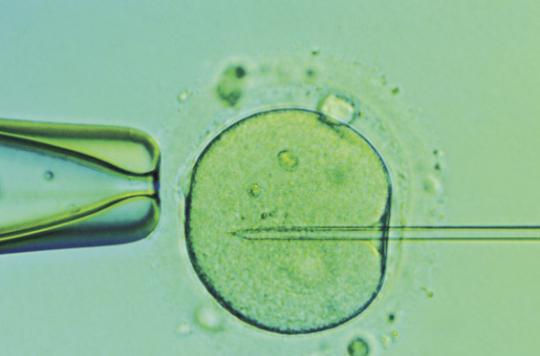MAINTENANCE . For the first time, a British team has been authorized to genetically manipulate embryos for research purposes.

The work has not yet started, which is already controversial. In the United Kingdom, a team of researchers has been authorized to perform genetic manipulation on embryos for research purposes, using the Crispr-Cas9 method, a tool as revolutionary as its name is unpronounceable.
The authorization was issued by the HFEA (Human Fertilization and Embryology Authority). The work fits into the field of reproductive science. They aim to better understand early embryonic development and, ultimately, the origin of miscarriages in women. The Francis Crick Institute team (London) submitted their application in September.
This is the first time in the UK that the Crispr-Cas9 method has been used to manipulate embryos. Much has been written about this method, since it allows DNA modification with surgical precision. Indeed, thanks to this tool, researchers can modify the expression of a gene, remove one and introduce a new one.
“Molecular scissors”
“These are molecular scissors,” explains Hervé Chneiweiss, director of the Inserm “Neuroscience Paris Seine” Unit and chairman of the Inserm Ethics Committee. It acts like a magnet that attaches itself to a specific strand of DNA – we can then target a gene in a very specific way. Then, this magnet (Crispr) attracts to itself an enzyme (Cas9) which cuts the DNA at this precise location ”.

Hervé Chneiweiss, research director and president of the ethics committee at Inserm: ” This revolutionary method has been authorized for three years in mammalian cells and in humans. It caused a technological tsunami. “
Researchers then have several choices. Either they interrupt the expression of the target gene, so as to understand how it works – this will be the case in future work which has obtained the green light from the British health authorities. Either they replace the gene (carrier of the disease, for example) by another equivalent gene, a sort of “guide”. “So, we are in a gene surgery”, explains Hervé Chneiweiss.
Embryonic development: identifying the genes involved
In the British work, it is a question of knowing more about the genes involved in the development of the cells which will subsequently form the placenta. In fact, among the 22,000 or so genes that make up our genome, “we do not know how to identify with precision those which are absolutely necessary for a good development of the embryo”, adds Hervé Chneiweiss. This work should shed more light on the reasons why some embryos develop successfully, when others fail.

Herve Chneiweiss : ” Between fertilization and birth, 90% of fertilized eggs are lost (50% within 5 days of fertilization). It is about understanding the mechanisms underlying this loss. “
Get out of fantasy
We are therefore very far from an embryonic selection that tomorrow will make it possible to create a world from “genetically modified embryos” and other made-to-measure babies. Opponents of embryonic manipulation denounce the risks of eugenic drifts. If their arguments are not lacking in interest, it should be remembered that this research takes place within a strict framework that does not allow obscure scientists to realize their wildest dreams.
Thus, British law requires embryos to be destroyed after two weeks. Of course, there is no question of reimplanting them in a woman’s uterus. “We are in pure fundamental research, there is no prospect of application”, recalls Hervé Chneiweiss.
Moreover, the scientific objective appears clearly here – unlike a previous experiment, where Chinese researchers used Crispr-Cas9 for the first time on embryos, without a specific objective, according to the many specialists who have expressed themselves on the question. “It was above all a matter of playing around with this method,” says Hervé Chneiweiss.
The English, pioneers in embryo research
The English are pioneers in embryonic research. It is to them that the world owes the IVF technique, carried out for the first time on their soil in 1998. It is also the first country in the world to have supervised research on the embryo. In addition, the research center which will carry out this work is headed by Paul Nurse, 2001 Nobel Prize winner for medicine. If this does not certify the degree of honesty of the researchers he directs, we can nevertheless see in it a guarantee of the seriousness of this project.
Research: Green light from UK authorities for genetic manipulation of embryos https://t.co/h8QvNDMtGf pic.twitter.com/wl01GWOOf1
– Pourquoidocteur (@Pourquoidocteur) February 2, 2016
.
















